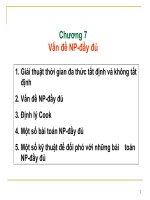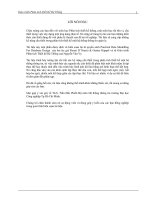Giáo trình Phân tích thiết kế Giải thuật nâng cao Geometric Algorithms
Bạn đang xem bản rút gọn của tài liệu. Xem và tải ngay bản đầy đủ của tài liệu tại đây (1.28 MB, 62 trang )
1
Geometric Algorithms
primitive operations
convex hull
closest pair
voronoi diagram
References:
Algorithms in C (2nd edition), Chapters 24-25
/>2
Geometric Algorithms
Applications.
•
Data mining.
•
VLSI design.
•
Computer vision.
•
Mathematical models.
•
Astronomical simulation.
•
Geographic information systems.
•
Computer graphics (movies, games, virtual reality).
•
Models of physical world (maps, architecture, medical imaging).
History.
•
Ancient mathematical foundations.
•
Most geometric algorithms less than 25 years old.
Reference: />airflow around an aircraft wing
3
primitive operations
convex hull
closest pair
voronoi diagram
4
Geometric Primitives
Point: two numbers (x, y).
Line: two numbers a and b [ax + by = 1]
Line segment: two points.
Polygon: sequence of points.
Primitive operations.
•
Is a point inside a polygon?
•
Compare slopes of two lines.
•
Distance between two points.
•
Do two line segments intersect?
•
Given three points p
1
, p
2
, p
3
, is p
1
-p
2
-p
3
a counterclockwise turn?
Other geometric shapes.
•
Triangle, rectangle, circle, sphere, cone, …
•
3D and higher dimensions sometimes more complicated.
any line not through origin
5
Intuition
Warning: intuition may be misleading.
•
Humans have spatial intuition in 2D and 3D.
•
Computers do not.
•
Neither has good intuition in higher dimensions!
Is a given polygon simple?
we think of this algorithm sees this
1 6 5 8 7 2
7 8 6 4 2 1
1 15 14 13 12 11 10 9 8 7 6 5 4 3 2
1 2 18 4 18 4 19 4 19 4 20 3 20 3 20
1 10 3 7 2 8 8 3 4
6 5 15 1 11 3 14 2 16
no crossings
6
Polygon Inside, Outside
Jordan curve theorem. [Veblen 1905] Any continuous simple closed
curve cuts the plane in exactly two pieces: the inside and the outside.
Is a point inside a simple polygon?
Application. Draw a filled polygon on the screen.
/>7
public boolean contains(double x0, double y0)
{
int crossings = 0;
for (int i = 0; i < N; i++)
{
double slope = (y[i+1] - y[i]) / (x[i+1] - x[i]);
boolean cond1 = (x[i] <= x0) && (x0 < x[i+1]);
boolean cond2 = (x[i+1] <= x0) && (x0 < x[i]);
boolean above = (y0 < slope * (x0 - x[i]) + y[i]);
if ((cond1 || cond2) && above ) crossings++;
}
return ( crossings % 2 != 0 );
}
Polygon Inside, Outside: Crossing Number
Does line segment intersect ray?
y
0
=
y
i+1
- y
i
x
i+1
- x
i
(x
0
- x
i
) + y
i
x
i
x
0
x
i+1
(x
i
, y
i
)
(x
i+1
, y
i+1
)
(x
0
, y
0
)
8
CCW. Given three point a, b, and c, is a-b-c a counterclockwise turn?
•
Analog of comparisons in sorting.
•
Idea: compare slopes.
Lesson. Geometric primitives are tricky to implement.
•
Dealing with degenerate cases.
•
Coping with floating point precision.
Implementing CCW
c
a
b
yes
b
a
c
no
c
a
b
Yes
( slope)
c
a
b
???
(collinear)
c
b
a
???
(collinear)
b
a
c
???
(collinear)
< 0> 0
9
Implementing CCW
CCW. Given three point a, b, and c, is a-b-c a counterclockwise turn?
•
Determinant gives twice area of triangle.
•
If area > 0 then a-b-c is counterclockwise.
•
If area < 0, then a-b-c is clockwise.
•
If area = 0, then a-b-c are collinear.
2 Area(a, b, c) =
a
x
a
y
1
b
x
b
y
1
c
x
c
y
1
= (b
x
a
x
)(c
y
a
y
) (b
y
a
y
)(c
x
a
x
)
(a
x
, a
y
)
(b
x
, b
y
)
(c
x
, c
y
)
(a
x
, a
y
)
(b
x
, b
y
)
(c
x
, c
y
)
10
Immutable Point ADT
public final class Point
{
public final int x;
public final int y;
public Point(int x, int y)
{ this.x = x; this.y = y; }
public double distanceTo(Point q)
{ return Math.hypot(this.x - q.x, this.y - q.y); }
public static int ccw(Point a, Point b, Point c)
{
double area2 = (b.x-a.x)*(c.y-a.y) - (b.y-a.y)*(c.x-a.x);
if else (area2 < 0) return -1;
else if (area2 > 0) return +1;
else if (area2 > 0 return 0;
}
public static boolean collinear(Point a, Point b, Point c)
{
return ccw(a, b, c) == 0;
}
}
11
Intersect: Given two line segments, do they intersect?
•
Idea 1: find intersection point using algebra and check.
•
Idea 2: check if the endpoints of one line segment are on different
"sides" of the other line segment.
•
4 ccw computations.
Sample ccw client: Line intersection
not handled
public static boolean intersect(Line l1, Line l2)
{
int test1, test2;
test1 = Point.ccw(l1.p1, l1.p2, l2.p1)
* Point.ccw(l1.p1, l1.p2, l2.p2);
test2 = Point.ccw(l2.p1, l2.p2, l1.p1)
* Point.ccw(l2.p1, l2.p2, l1.p2);
return (test1 <= 0) && (test2 <= 0);
}
l1.p1
p2
l2.p1
p2
12
primitive operations
convex hull
closest pair
voronoi diagram
13
Convex Hull
A set of points is convex if for any two points p and q in the set,
the line segment pq is completely in the set.
Convex hull. Smallest convex set containing all the points.
Properties.
•
"Simplest" shape that approximates set of points.
•
Shortest (perimeter) fence surrounding the points.
•
Smallest (area) convex polygon enclosing the points.
convex
not convex
convex hull
p
q
p
q
14
Mechanical Solution
Mechanical algorithm. Hammer nails perpendicular to plane;
stretch elastic rubber band around points.
/>15
Brute-force algorithm
Observation 1.
Edges of convex hull of P connect pairs of points in P.
Observation 2.
p-q is on convex hull if all other points are counterclockwise of pq.
O(N
3
) algorithm.
For all pairs of points p and q in P
•
compute ccw(p, q, x) for all other x in P
•
p-q is on hull if all values positive
p
q
16
Package Wrap (Jarvis March)
Package wrap.
•
Start with point with smallest y-coordinate.
•
Rotate sweep line around current point in ccw direction.
•
First point hit is on the hull.
•
Repeat.
17
Package Wrap (Jarvis March)
Implementation.
•
Compute angle between current point and all remaining points.
•
Pick smallest angle larger than current angle.
•
(N) per iteration.
18
How Many Points on the Hull?
Parameters.
•
N = number of points.
•
h = number of points on the hull.
Package wrap running time. (N
h) per iteration.
How many points on hull?
•
Worst case: h = N.
•
Average case: difficult problems in stochastic geometry.
in a disc: h = N
1/3
.
in a convex polygon with O(1) edges: h = log N.
19
Graham Scan: Example
Graham scan.
•
Choose point p with smallest y-coordinate.
•
Sort points by polar angle with p to get simple polygon.
•
Consider points in order, and discard those that
would create a clockwise turn.
p
20
Graham Scan: Example
Implementation.
•
Input: p[1], p[2], …, p[N] are points.
•
Output: M and rearrangement so that p[1], ,p[M] is convex hull.
Running time. O(N log N) for sort and O(N) for rest.
// preprocess so that p[1] has smallest y-coordinate
// sort by angle with p[1]
points[0] = points[N]; // sentinel
int M = 2;
for (int i = 3; i <= N; i++)
{
while (Point.ccw(p[M-1], p[M], p[i]) <= 0) M ;
M++;
swap(points, M, i);
}
why?
discard points that would create clockwise turn
add i to putative hull
21
Quick Elimination
Quick elimination.
•
Choose a quadrilateral Q or rectangle R with 4 points as corners.
•
Any point inside cannot be on hull
4 ccw tests for quadrilateral
4 comparisons for rectangle
Three-phase algorithm
•
Pass through all points to compute R.
•
Eliminate points inside R.
•
Find convex hull of remaining points.
In practice
can eliminate almost all points in linear time.
Q
these
points
eliminated
R
22
Convex Hull Algorithms Costs Summary
t assumes "reasonable" point distribution
Package wrap
algorithm
Graham scan
Sweep line
Quick elimination
N h
growth of
running time
N log N
N log N
N
t
Quickhull N log N
Best in theory N log h
Mergehull N log N
Asymptotic cost to find h-point hull in N-point set
output sensitive
23
Convex Hull: Lower Bound
Models of computation.
•
Comparison based: compare coordinates.
(impossible to compute convex hull in this model of computation)
•
Quadratic decision tree model: compute any quadratic function
of the coordinates and compare against 0.
Theorem. [Andy Yao, 1981] In quadratic decision tree model,
any convex hull algorithm requires (N log N) ops.
higher degree polynomial tests
don't help either [Ben-Or, 1983]
even if hull points are not required to be
output in counterclockwise order
(a.x < b.x) || ((a.x == b.x) && (a.y < b.y)))
(a.x*b.y - a.y*b.x + a.y*c.x - a.x*c.y + b.x*c.y - c.x*b.y) < 0
24
primitive operations
convex hull
closest pair
voronoi diagram
25
Closest pair problem
Given: N points in the plane
Goal: Find a pair with smallest Euclidean distance between them.
Fundamental geometric primitive.
•
Graphics, computer vision, geographic information systems,
molecular modeling, air traffic control.
•
Special case of nearest neighbor, Euclidean MST, Voronoi.
Brute force.
Check all pairs of points p and q with (N
2
) distance calculations.
1-D version. O(N log N) easy if points are on a line.
Degeneracies complicate solutions.
[ assumption for lecture: no two points have same x coordinate]
as usual for geometric algs
fast closest pair inspired fast algorithms for these problems









